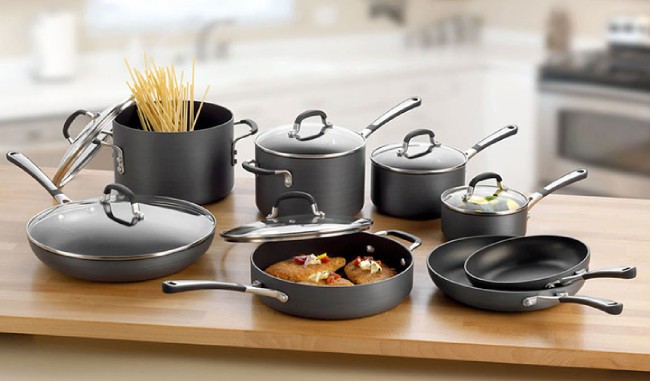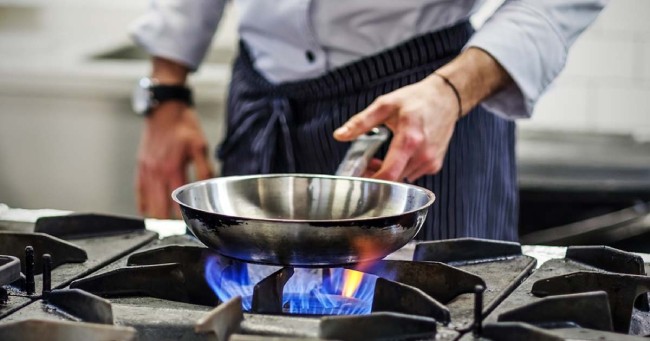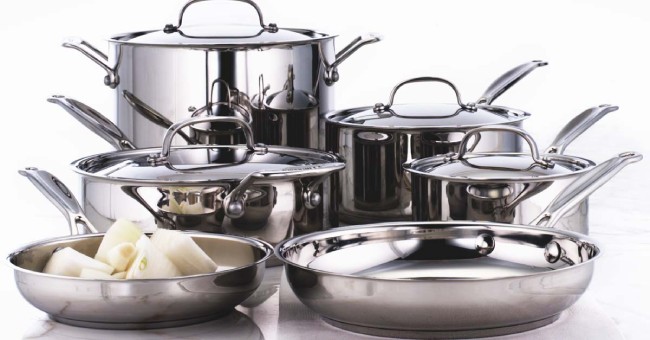Are you looking for the essential pots and pans that every gas stove kitchen needs? Do you want to upgrade an outdated cookware collection but need clarification on what’s necessary to cook on a gas stove successfully? Look no further.
In this comprehensive blog post, I’ll discuss the seven essential pieces of cookware that any serious home chef needs to produce healthy and delicious meals on their gas stove. From performance tips to product recommendations, we will help you find the perfect pots and pans for your skillset so that you can create crowd-pleasing food time after time!
The Science Behind Cooking with Gas Stoves
A brief explanation of how gas stoves work
Gas stoves are fueled by natural gas or propane and work through a careful combustion and heat transfer combination.
The flame from the burner is used to ignite the combustible gas, which then produces heat that is transferred via direct radiation, convection, and conduction to cook food. Gas flames can generally be adjusted more precisely than other stoves, giving home cooks more control over the cooking process.

The advantages and challenges of cooking with gas stoves
Cooking with gas stoves provides numerous advantages over electric models, including faster heating and cooling times, easier temperature control, higher temperatures for searing and frying, and more efficient energy use. On the other hand, there are a few challenges associated with using gas stoves:
- Dangerous open flame.
- Risk of carbon monoxide poisoning from improperly vented stoves.
- The need to use unique cookware that conducts heat well.
Discussing the heat distribution with gas stoves
Gas stoves are known for evenly distributing heat, which is a distinct advantage over electric ones. This is because the flame of a gas stove can produce more direct heat that spreads out quickly and efficiently throughout the pan or pot being used.
The relatively high temperatures of gas burners have also allowed home cooks to achieve better browning and caramelization. Finally, efficiently controlling the heat produced can minimize the risk of burning food or creating unevenly cooked meals.
Factors to Consider When Selecting Pots and Pans for Gas Stoves
Material compatibility with gas stoves: Many types of pots and pans are unsuitable for gas stoves. Non-magnetic stainless steel, aluminum, and cast iron are typically safe to use on gas stoves. Checking the manufacturer’s instructions before purchasing any cookware is essential, as some materials can release toxic chemicals when heated.
Importance of heat distribution and retention: Pots and pans should be able to distribute heat evenly while holding in the heat. This helps ensure that food is cooked evenly without burning. Cast iron cookware is known for its excellent heat retention properties, while aluminum has good heat distribution qualities and can be cheaper than other materials.
Choosing the right size and weight: The size and weight of pots and pans are vital factors to consider when selecting cookware for a gas stove. Lighter items tend to heat up faster, while heavier items have better heat retention. It is also essential to choose a pot or pan that is the right size for your specific stovetop – too small an object may cause heat buildup and uneven cooking, while too large an item can cause stability issues.
The relevance of handle design and comfort: The handles of pots and pans should be comfortable to hold, with a design that allows for a secure grip. It is also essential to ensure that the handle does not become too hot when exposed to heat – look for materials such as plastic or silicone that can keep cool even when heated.
The 7 Most Essential Pots and Pans for Gas Stove Cooking
Cast Iron Skillet
A detailed description of a cast iron skillet
A cast iron skillet is essential for cooking over a gas stove. Cast iron helps distribute heat evenly and can fry, sauté, bake, and more. It is also incredibly durable and long-lasting, making it a worthwhile investment.
Benefits and uses of a gas stove setup
Cast iron is an excellent choice for cooking on a gas stove because it is incredibly durable and can withstand high temperatures. It also helps distribute heat, allowing you to cook food more efficiently, quickly, and evenly. Cast iron skillets are perfect for frying, sautéing, baking, and more. They can also be used in the oven or over an open flame.
Stainless Steel Saucepan
A detailed description of a stainless steel saucepan
A stainless steel saucepan is a kitchen essential. Perfect for boiling sauces, simmering stews, or making risotto, it’s an incredibly versatile cookware that deserves a place in every gas stove kitchen. Heat quickly and evenly with superior heat conduction; stainless steel saucepans offer durability and convenience to make your cooking experience delightful.

Benefits and uses of a gas stove setup
A stainless steel saucepan is perfect for gas stove cooking. Their superior heat conduction allows you to cook evenly and quickly while simplifying cleanup. You can make various dishes with one versatile pot, such as risotto, sauces, and stews. With its durable construction and convenient features, a stainless steel saucepan is essential for every gas stove kitchen.
Nonstick Frying Pan
A detailed description of a nonstick frying pan
A nonstick frying pan is a must-have for any gas stove kitchen. It’s perfect for cooking eggs, pancakes, and other delicate dishes that can easily stick to the surface of a regular pan. Nonstick pans are also great for low-oil cooking because they require less oil or butter to prevent sticking. They are easy to clean and built to last if you properly care for them.
Benefits and uses of a gas stove setup
Nonstick pans are essential for any gas stove setup because they prevent food from sticking and make cleaning a breeze. They’re also great for delicate dishes that require precise temperature control, such as omelets and crepes. Nonstick pans need less oil or butter, making them a healthier cooking option.
Dutch Oven
A detailed description of a Dutch oven
A Dutch oven is a large, heavy pot usually made of cast iron. It has a tight-fitting lid and an interior surface that can be used for stovetop and oven cooking. The sides are tall enough to allow for sauces, stews, roasts, or other significant cuts of meat. Dutch ovens are durable and can be used over an open flame, making them an excellent choice for camping.
Benefits and uses of a gas stove setup
Dutch ovens are great for slow cooking, braising, stewing, and roasting. Their heavy construction keeps heat in and results in even cooking. The tight-fitting lid helps to keep moisture in while allowing steam to escape. This means that meats can be simmered with less chance of drying out or burning.
Dutch ovens also have excellent heat retention, meaning you can use less energy while cooking. With a Dutch oven, you often get more flavorful dishes requiring less hands-on time.
Copper Chef Pan
A detailed description of a copper chef pan
The Copper Chef pan is an all-in-one cooking tool used to sear, sauté, bake, and steam. It has raised ridges on its interior, which help to create a crispier crust when cooking over high heat, and its nonstick coating makes it easier to clean up.
Its unique square shape also allows for more even cooking temperatures as well as better heat distribution. This pan is perfect for gas stovetop cooking and can make many delicious dishes, from sauces, omelets, stir-fries, and more!
Benefits and uses of a gas stove setup
This pan is excellent for making delicious meals on a gas stovetop. Its raised ridges create an evenly cooked, crispy crust, and its nonstick coating makes it easier to clean up after use. Additionally, its square shape allows for better heat distribution and more even cooking temperatures.
This pan can be used to sear, sauté, bake, and steam, and it can also be used to make various dishes, from sauces, omelets, stir-fries, and more! Its versatility makes it an essential tool for any gas stove setup.
Sauté Pan
A detailed description of a sauté pan
A sauté pan is an essential tool for gas stove cooking. Its unique shape makes it the perfect vessel for browning, searing, and making sauces. Typically constructed with a long handle and high sides, the sauté pan cooks food quickly over direct heat while preventing splattering. It also works well for braising and one-pot meals. This versatile piece of kitchenware is essential for any gas stove cook.
Benefits and uses of a gas stove setup
The sauté pan is the most versatile pot and pan for gas stove cooking. Its shape makes it ideal for high-heat tasks like searing, browning, and deglazing. Its long handle and deep sides make it perfect for braising and one-pot meals.
The sauté pan’s lid seals in moisture and keeps food from burning, ensuring evenly cooked meals. The lid also allows you to reduce sauces without fear of splattering or making a mess. The sauté pan is an essential item for any gas stove cook.
Wok
A detailed description of a wok
A wok is essential for cooking stir-fried dishes and sautéing vegetables quickly and deliciously. Its sloped sides make it easy to toss ingredients as they cook, while its wide surface area allows you to spread heat evenly across the pan. Look for a carbon steel wok with a flat bottom that will fit securely onto your gas stove burner.
Benefits and uses of a gas stove setup
A wok is a must-have for any gas stove kitchen. Its heat distribution and size make it perfect for quick cooking, searing, and stir-frying, while its shape makes tossing ingredients easy. You can also use a wok to steam foods like dumplings or vegetables. A carbon steel wok can last for years and develop a beautiful patina with proper care.

Care and Maintenance of Pots and Pans for Gas Stove Cooking
Overview of general care and maintenance tips
Caring for your pots and pans is essential to maintain their longevity. Here are some general tips you can apply when cleaning any of the items on our list:
- Wash the pots and pans with hot, soapy water after each use.
- Rinse thoroughly and dry with a cloth over low heat.
- Use a non-abrasive scrubber or sponge to remove any remaining food residue, as metal scratching can damage the surface.
- Avoid using steel wool pads and other abrasives on cookware surfaces.
- When storing, place pot lids upside down so that condensation does not collect inside the cover.
- Always use oven mitts when handling hot cookware.
- Whenever possible, store your pots and pans in an area that will keep them clean and dry.
- Don’t stack metal cookware together, as this can create surface scratches.
- Avoid extreme temperature changes with cast iron cookware or put it in the dishwasher.
- Use only wooden utensils with nonstick cookware to avoid scratching the surface.
Breakdown of care instructions for each pot and pan mentioned
Now that you have an overview of the general care and maintenance tips for your pots and pans take a look at this breakdown to learn more about specific instructions for each item:
- Skillet: After washing, season with oil or shortening, then bake upside down in a 350°F oven for one hour.
- Dutch oven: A good scrub with a brush or sponge and hot water is usually all you’ll need.
- Saucepan: After washing, use a soft cloth to apply vegetable oil to the inside surface to prevent rusting.
- Stockpot: Use non-abrasive scrubbers and warm soapy water when cleaning.
- Sauté pan: Use warm soap and water for stainless steel pans and dry with a soft cloth.
- Grill pan: Avoid using abrasives or metal scouring pads when cleaning this pan.
- Wok: Use hot soapy water to clean, then place on low heat for a few minutes to remove any remaining moisture.
Importance of proper care for longevity and optimal performance
Proper care and maintenance of your pots and pans are essential for longevity and optimal performance. Follow the instructions above for each item, and you’ll be sure to get the most out of your cookware. If you take good care of your cookware, it can last a lifetime!
FAQ about The 7 Most Essential Pots and Pans for Gas Stove Cooking
Can all pots and pans be used on gas stoves?
No, not all pots and pans can be used on gas stoves. It is essential to select the appropriate cookware for your gas stove so that it will heat adequately. Gas stoves require cookware that has a flat bottom and conducts heat well. Pots and pans made from cast iron, stainless steel, or copper are the best options for gas stove cooking, as they are designed to distribute heat evenly and quickly.
How do I clean and care for my pots and pans properly?
It is essential to clean and care for your pots and pans properly. Always use a non-abrasive cleaner or sponge when washing, as abrasive materials can cause scratches, eventually leading to food sticking to the surface of the pan. Once cleaned, it is also essential to thoroughly dry the pots and pans before storing them.
This will help prevent rust or discoloration from forming on the metal. It would help if you also tried to avoid stacking pots and pans on each other, as this can cause them to become scratched or dented. Lastly, apply a light coat of cooking oil when storing your pots and pans to keep them in good condition.
Why does the material of the pot or pan matter when cooking on a gas stove?
The material of the pot or pan matters when cooking on a gas stove because different materials will conduct heat differently.
For example, cast iron works heat evenly and quickly, which makes it an ideal choice for gas stoves. On the other hand, aluminum does not retain heat either and can cause hot spots in certain areas of the pan. Choosing the correct type of cookware for your gas stove is essential to ensure that your food cooks evenly.
Conclusion on The 7 Most Essential Pots and Pans for Gas Stove Cooking
Having the right cookware for a gas stove is essential to ensure that your food cooks evenly and quickly. Pots and pans made from cast iron, stainless steel, or copper are the best options for gas stove cooking, as they are designed to distribute heat evenly and quickly.
Proper cleaning and care of your pots and pans is also vital to keep them in good condition. You can enjoy delicious meals cooked on your gas stove for years with the right cookware and proper care.
Read more:

